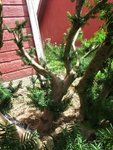Javaman4373
Shohin
I have a yew shrub in front of one of my barns that is about 8 ft tall. It has 5 major stems and one smaller one emerging from a large woody base. I am in the process of collecting bonsai material from this tree. This summer two air layers are in progress, one on a branch of about 1.25 inch diameter, and one on a large trunk at the base, about 4-5 inches in diameter. The yew was pruned some this spring and has quite a bit of back budding in progress. I am in SW Vermont, so the air layers will have to be cut off before winter. I would like to collect a large trunk on the back side of the yew and it presents two options. One air layer it near its base. Two dig it out in the spring. The latter option would involve cutting it from the base with a chain saw. One advantage of digging it out is it has some nice roots for nebari. My major question is would such a chain saw step be a deal breaker for its survival and making a bonsai.





